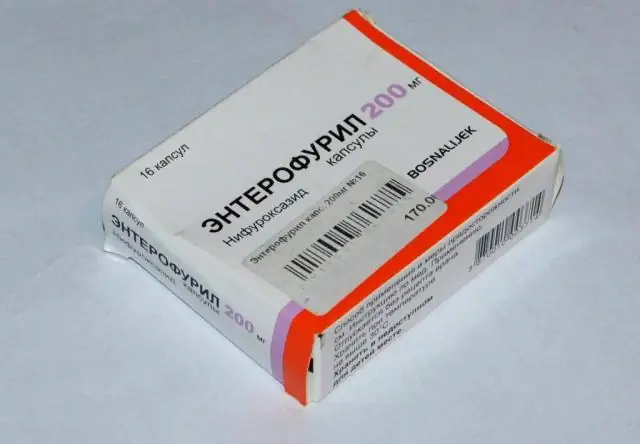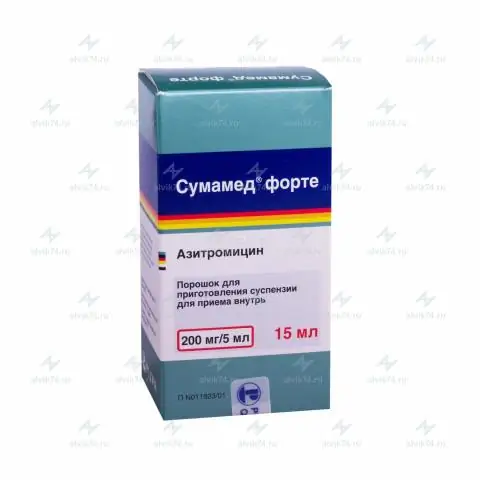- Author Rachel Wainwright [email protected].
- Public 2023-12-15 07:39.
- Last modified 2025-11-02 20:14.
Urseptia
Urseptia: instructions for use and reviews
- 1. Release form and composition
- 2. Pharmacological properties
- 3. Indications for use
- 4. Contraindications
- 5. Method of application and dosage
- 6. Side effects
- 7. Overdose
- 8. Special instructions
- 9. Application during pregnancy and lactation
- 10. Use in childhood
- 11. In case of impaired renal function
- 12. For violations of liver function
- 13. Use in the elderly
- 14. Drug interactions
- 15. Analogs
- 16. Terms and conditions of storage
- 17. Terms of dispensing from pharmacies
- 18. Reviews
- 19. Price in pharmacies
Latin name: Urseptiya
ATX code: J01MB04
Active ingredient: pipemidic acid (Рipemidic acid)
Manufacturer: OOO Velpharm (Russia)
Description and photo update: 2020-05-03
Prices in pharmacies: from 279 rubles.
Buy

Urseptia is an antimicrobial agent belonging to the quinolone group.
Release form and composition
The drug is produced in the form of capsules: size No. 1, gelatinous, solid, the capsule body is white, the cap is green; inside capsules contains powder from white with a yellowish tinge to pale yellow, lumps may form (in blisters of 10, 15 or 20 capsules, in a cardboard box 1-10 packs; in polypropylene polymer cans of 40, 60 or 80 capsules, in a cardboard box of 1 can. Each pack also contains instructions for the use of Ursepta).
Composition of 1 capsule:
- active ingredient: pipemidic acid trihydrate - 236 mg (corresponds to 200 mg of pipemidic acid);
- additional substances: magnesium stearate, milk sugar (lactose monohydrate), aerosil (colloidal silicon dioxide), sodium carboxymethyl starch (sodium starch glycolate, primogel);
- capsule body and cap: gelatin, titanium dioxide; additionally for the cap - quinoline yellow and brilliant blue dyes.
Pharmacological properties
Pharmacodynamics
Urseptia is a drug from the group of quinolones, used in the treatment of infectious diseases of the urinary system, which are caused by pathogens sensitive to pipemidic acid.
Under the action of pipemidic acid, bacterial DNA topoisomerase II is inhibited, which leads to the disintegration of bacterial DNA. The effect is more pronounced in relation to microorganisms in the proliferation phase.
Pipemidic acid in high concentrations inhibits both the synthesis of bacterial proteins and the synthesis of RNA. The bactericidal action of Ursepta extends to most gram-negative aerobic microorganisms (Klebsiella pneumoniae, Neisseria spp., Proteus vulgaris, Pseudomonas aeruginosa, Proteus mirabilis, Escherichia coli and others).
The percentage of emergence of resistance ranges from 10% (Staphylococcus aureus, Escherichia coli) to 62% (Pseudomonas aeruginosa).
Gram-positive microorganisms show resistance to the action of pipemidic acid.
The drug is not active against anaerobes.
Pipemidic acid accumulates in urine in high concentrations; when urine is alkalized, its activity increases.
Pharmacokinetics
When taken orally, Ursepta, pipemidic acid is absorbed quickly, bioavailability ranges from 30 to 60%. After oral administration in a dose of 400 mg, the maximum concentration (3.5 μg / ml) is observed after 70-80 minutes.
Binds to plasma proteins by about 30%, the degree of binding depends on the concentration of pipemidic acid in the blood serum.
The substance accumulates in high concentrations in the fluid of the prostate gland, kidneys and urine. Like other quinolone compounds, pipemidic acid is able to cross the placenta and is found in human milk in trace amounts.
It is excreted from the body mainly through the kidneys unchanged. In daily urine, from 50 to 85% of the dose taken is determined. The release of pipemidic acid directly depends on the creatinine clearance (CC). T 1/2 (half-life) in the absence of impaired renal function is 2 hours 15 minutes, and the total clearance is 6.3 ml / min.
In patients with renal dysfunction, the level of the concentration of pipemidic acid in the blood plasma is higher than in healthy volunteers. T 1/2 of their blood plasma is slightly prolonged and varies within 5.7-16 hours.
Indications for use
Capsules Urseptia 200 mg is used for acute and chronic infectious and inflammatory diseases of the urinary tract caused by microorganisms that are sensitive to pipemidic acid, including cystitis, pyelonephritis, prostatitis.
Contraindications
Absolute:
- diseases of the central nervous system (epilepsy and other neurological conditions with a low seizure threshold);
- lactose intolerance, lactase deficiency, glucose-galactose malabsorption;
- severe impairment of renal function with CC less than 10 ml / min;
- severe hepatic impairment (including cirrhosis);
- a history of allergic reactions to quinolones;
- porphyria;
- gestation period;
- lactation (breastfeeding);
- age up to 18 years (since it can have a negative impact on the formation and growth of the skeleton);
- hypersensitivity to pipemidic acid or any of the components in the drug.
Relative (use capsules Urseptia with caution):
- deficiency of glucose-6-phosphate dehydrogenase;
- violation of cerebral circulation;
- renal failure with CC from 10 to 30 ml / min;
- advanced age (over 70).
Urseptia, instructions for use: method and dosage
Urseptia capsules are used orally before meals with water.
Recommended dosage: 2 capsules (400 mg) 2 times a day (morning and evening) with an interval of 12 hours between doses.
The duration of therapy is about 10 days. If necessary, the course of treatment can be extended, but it should not exceed 28 days.
In patients with cystitis, the course of treatment lasts 3 days.
In severe renal failure (CC from 10 to 30 ml / min), the dose of pipemidic acid should be reduced.
Elderly patients without impaired renal function, as well as patients with mild and moderate hepatic insufficiency, do not need to adjust the dose of Urseptia.
During the course of treatment with pipemidic acid, the patient needs to drink plenty of fluids.
Side effects
- nervous system: headache, vertigo, confusion, hallucinations, agitation, sensory disturbances, sleep disturbances, depression, visual impairment, tremors, prolonged convulsions associated with cerebral edema;
- digestive organs: anorexia, gastralgia, heartburn, vomiting, nausea, abdominal pain, bloating, constipation, diarrhea, pseudomembranous colitis;
- skin: rash, itching, toxic epidermal necrolysis (Lyell's syndrome), photosensitivity with erythema;
- laboratory parameters: reversible thrombocytopenia (in patients with renal failure and elderly patients) eosinophilia, hemolytic anemia (in patients with glucose-6-phosphate dehydrogenase deficiency);
- other disorders: tendonitis, acute arthropathy, superinfection.
Overdose
The occurrence of life-threatening adverse reactions or death due to an overdose of Urseptia has not been reported. There is no specific antidote.
Symptoms: nausea / vomiting, headache, dizziness, confusion, tremors, seizures.
Therapy: gastric lavage (if no more than 4 hours have passed since the last capsule intake), the use of activated carbon, forced diuresis, hemodialysis; in the case of development of undesirable reactions from the nervous system, for example, epileptic seizures, symptomatic therapy is used (diazepam is indicated).
A patient with suspected pipemidic acid overdose should be under medical supervision.
special instructions
The undesirable effects of the organs and systems of the body that occur when taking Ursepta are in most cases weak and transient, therefore, as a rule, they do not require discontinuation of the drug. If a patient develops allergic reactions in response to drug therapy, it should be discontinued.
During the course of treatment, it is necessary to avoid ultraviolet radiation, since the risk of photosensitization at this time is quite high. In patients with glucose-6-phosphate dehydrogenase deficiency, hemolytic anemia may develop.
With prolonged use of Ursepta, it is necessary to monitor the general blood counts, determine the functions of the kidneys and liver, and repeat the determination of the sensitivity of the microflora to the drug.
During the course of treatment, it is necessary to increase the amount of fluid consumed (under the control of diuresis).
Patients with impaired renal function (CC from 10 to 30 ml / min) and patients over the age of 70 (due to the increased incidence of adverse reactions) Urseptia is prescribed with caution. Regular monitoring of the patient's condition and, if necessary, dose adjustment is required. The drug is contraindicated in patients with anuria and oliguria, as well as with CC values less than 10 ml / min.
If there is a history of data on cerebrovascular accident (including information about cerebral hemorrhage and cerebral vasospasm) and seizures, Urseptia should be taken with caution.
A false-positive reaction to urine glucose may occur when using Fehling's or Benedict's reagents. It is recommended to use enzymatic reactions with glucose oxidase.
Influence on the ability to drive vehicles and complex mechanisms
During the period of treatment with Urseptia, the patient should refrain from engaging in potentially hazardous activities that require increased concentration of attention and speed of psychomotor reactions.
Application during pregnancy and lactation
It is contraindicated to use the drug for pregnant and breastfeeding women.
Since pipemidic acid is excreted in breast milk, if it is necessary to use Ursepta during lactation, it is necessary to interrupt breastfeeding.
Pediatric use
Urseptia is contraindicated in patients under the age of 18, as it can have a negative effect on the formation and growth of the skeleton.
With impaired renal function
Severe renal dysfunction is a contraindication to the use of Urseptia.
Patients with renal insufficiency (CC from 10 to 30 ml / min) should take the drug with caution.
For violations of liver function
Severe liver dysfunction, including cirrhosis, is a contraindication to taking Ursepta.
Use in the elderly
Elderly patients (over 70 years old) need to observe precautions when taking Ursepta.
Drug interactions
Possible interactions of pipemidic acid with other drugs when used together:
- theophylline and caffeine: while using the drug, their metabolism slows down, since pipemidic acid inhibits the enzyme of the cytochrome P450 system. With the combined intake of T 1/2 theophylline increases, its concentration in the blood serum increases by 40-80% (control of the concentration of theophylline in the blood plasma is required), the content of caffeine in the blood serum increases by 2-4 times;
- antacids and sucralfate: cause a significant delay in the absorption of pipemidic acid; between the receptions of these funds, it is necessary to observe 2-3-three-hour intervals. A similar effect was not observed with the simultaneous use of Urseptia with ranitidine and cimetidine;
- warfarin: pipemidic acid may enhance its anticoagulant effect;
- non-steroidal anti-inflammatory drugs (NSAIDs): seizures may occur;
- aminoglycosides: there is a synergistic bactericidal effect.
Analogs
The analogues of Urseptia are Berlocid, Biseptol, Trisseptol, Pipemidic acid, Vero-Pipemidine, Palin, Pipegal, Urolesan, Uropimide, Urosept, Furadonin, Furazolidone, Furagin, Kanefron, Cyston, etc.
Terms and conditions of storage
Keep out of the reach of children. Store in a place protected from light penetration at a temperature not exceeding 25 ° C.
The shelf life is 5 years. After the expiration of the expiration date indicated on the package, the medicinal product must not be used.
Terms of dispensing from pharmacies
Dispensed by prescription.
Reviews about Urseptia
Currently, there are no reviews about Urseptia on the Internet.
Price for Urseptia in pharmacies
In pharmacy chains, the price of Ursepta 200 mg is from 306 rubles. per package containing 20 capsules.
Urseptia: prices in online pharmacies
|
Drug name Price Pharmacy |
|
Urseptia 200 mg capsule 20 pcs. 279 r Buy |
|
Urseptia capsules 200mg 20 pcs. 335 RUB Buy |

Anna Kozlova Medical journalist About the author
Education: Rostov State Medical University, specialty "General Medicine".
Information about the drug is generalized, provided for informational purposes only and does not replace the official instructions. Self-medication is hazardous to health!






